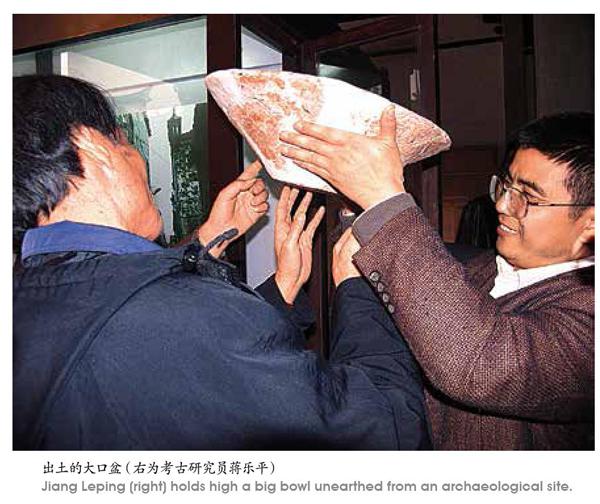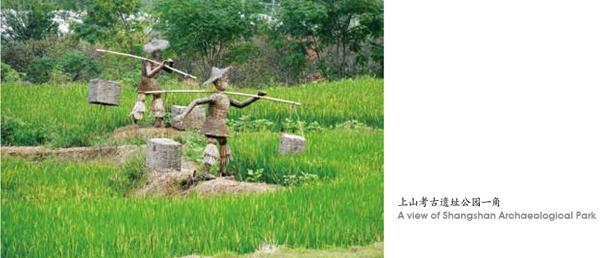万年遗址,撩开神秘面纱
2018-04-04傅淑青
傅淑青
浙江浦江县黄宅镇渠南村,有一个隐在农居房中的公园——上山考古遗址公园。站在公园外往内看,陈设布置似乎简单了些。但走进 A 和 B 这两处上山遗址核心展示区,才发现别有洞天。在这里,不仅可以看到上山文化图文并茂的精彩展示、观赏到早期新石器时代的珍贵文物,还可以体验万年以前的稻作农业文化。

怀着对上山文化的兴致,笔者多次在杭州与浦江之间往返,费尽心力,终于找到了上山遗址最初的发掘者、浙江省考古研究所研究员蒋乐平先生,以及多位知情者。他们为我撩开了上山文化的神秘面纱。
发现上山遗址之缘起
“说起浦江上山遗址,我想应从1996年的春天说起。那年我带着所里的同志,为配合杭金衢高速公路建设,在沿线进行全方位的文物勘探。在诸暨次坞的楼家桥,我们发现了沿线唯一一处新石器时代遗址。可把我乐坏了。”凭着高度的职业敏感,发掘完三期楼家桥遗址的蒋乐平,马上提出“浦阳江流域新石器时代遗址的调查与研究”课题,得到浙江省考古研究所大力支持后,立即投身于此。
2000年秋天,蒋乐平和团队来到位于浦阳江上游的浦江县黄宅镇渠南村,这是他此行着重调研的点位之一。因为就在此处,有个当地政府保护了多年的遗址。在上世纪70年代末,此处曾出土过三足鼎以及石头做的锄头、斧头等劳作物件。但因鉴定困难,直至本世纪初,遗址依旧“养在深山无人知”。
蒋乐平在对该遗址做试探性发掘时,惊喜地发现了陶罐、陶豆等物品,并确定这乃是良渚时期的新时代石器遗址。同时在周边发掘出同一时期、相同类型的墓地44座,据测算至今有4500年左右的历史,非常具有历史价值和研究意义。然而,更大的惊喜还在后面等着他。

蒋乐平和团队把目标尝试性地锁定一个叫做“上山”的小山丘。当时的蒋乐平怎么都没想到,这个看似普通、连地图上都没法画出的小山丘,竟埋藏了“万年遗址”;怎么都没想到这一锄下去,竟会让上山遗址重见天日。可以说,这一锄,直接改变了浙江的文明史!
那天究竟在上山发现了什么?虽已时隔十多年,蒋乐平记忆犹新。原来,他们挖到了炭红陶片和磨制的石锛。无论从质地、工艺还是外观看,这与良渚时期出土的新石器有着明显区别。因为现场无法判定,蒋乐平只能保守地估计这两个物件约有6000年的历史。他告诉笔者,当时的确很开心,但并不知道这是万年遗址,只是觉得运气不错,在一个小小的村庄,同时发现两处新石器时代遗址,这在全省乃至全国都是很少见的。
长达七年的艰苦发掘之路
“霜如雪/工地待日出/又恐足下泥半截/今日不能歇//雨靴配阳笠/考古队员称一绝/刮地惜三分/打探地层听消息……”蒋乐平一再笑称,这是多年前即兴而作的顺口溜。从这简短的50余字里,我们看到了考古队员的真实工作状态,也可以想象出其辛苦程度。
“无论烈日炎炎还是地冻天寒,只要一有时间,蒋先生都会带着团队,吃在上山、住在上山。”家住上山遗址附近的村民周成远回忆,自2000年秋天发现上山遗址以来,蒋乐平一行人就开始了长达6年的跟踪、挖掘、调查。皇天不负有心人!此后的几年间,蒋乐平和团队陆续发掘出了石球、陶器、建筑遗迹等具有新石器时代明显特征的文物,其中大口盆、平底盘、双耳罐等陶器,还羼和了一些稻壳、稻叶和稻茎。
2002年6月,蒋乐平取了四个夹炭陶片作为标本,请人转交给碳14年代测定的专业机构——北京大学文博学院。2003年1月中旬,令人振奋的好消息传来,这四个标本通过几轮校正,测定到准确的时间约为9000—11000年!
“这意味着什么?!这是一个万年遗址!而且,比萧山跨湖桥遗址的年代早了2000~3000年,比余姚河姆渡遗址早了3000~4000年!”蒋乐平的兴奋溢于言表。是的,上山遗址把浙江的史前文明足足往前推进了三四千年!兴奋之余,蒋乐平又有些后怕。因为在发现上山遗址之前,這个在当地人看来没什么用的小山丘,已列入2002年的土地平整规划当中。假若来晚一步,上山遗址很可能被夷为平地。
同年11月7日,《中国文物报》头版头条刊登了蒋乐平撰写的《浙江浦江县发现距今万年左右的早期新石器时代遗址》一文,引发不小的轰动。就这样,上山遗址开始被学术界和社会各界广泛关注,并被列入全国重点文物保护单位。
2005年年初,在嵊州的小黄山也发现了和上山遗址十分相似的文化类型,专家一致认为属同种地域文化,并提议是否可将上山遗址和小黄山遗址所代表的遗存内涵命名为一种新的考古学文化?2006年11月5日,在浦江县举行的“中国第四届环境考古学大会暨上山遗址学术研讨会”上,把上山遗址为代表的新石器时代早期文化被正式命名为“上山文化”。
前人栽树,后人乘凉。此后,在金华、永康、武义、龙游等地,又相继发现并发掘上山文化遗址18处。这应当是迄今中国境内乃至东亚地区以“上山遗址”为代表的,规模最大、分布最为集中的早期新石器时代遗址群。
顺势而建上山考古遗址公园
为了使上山遗址不受自然天气和人为破坏,2007年浦江县曾在核心区的上方加盖一个竹棚作为遮挡物。以前上山遗址并不对外开放,只用于专家、学者的观摩和研讨。

这些年,随着上山文化声名远扬,当地政府越来越重视。显然一个简陋的竹棚已无法与其匹配,打造一个集参观、展示、观赏、体验等功能于一体的场地非常有必要,这样既对遗址核心区起到保护作用,为往后考古研究提供良好条件,又能把这些年发掘的成果直观地展示给老百姓,带动当地的休闲旅游,于是上山考古遗址公园的建设便提上了议程。
“上山考古遺址公园规划面积为1206亩,于2016年6月正式动工。光第一期,我们县里就投入了2730万元的资金,通过5个月时间的紧张建设,完成了遗址公园第一期 A、B 两馆核心区的验收工作”,浦江县博物馆馆长朱江平如是说。
2016年的11月21日—24日,“‘上山文化命名十周年暨稻作农业起源国际学术研讨会”在浦江举办。上山考古遗址公园正好以此盛会为契机,遂定于2016年11月22日正式开放的时间。值得一提的是,在此次会议上,国内外150余位专家学者对上山遗址的保护及陈展模式,给予了充分肯定。考古学界泰斗严文明先生还称,可以把上山遗址保护工程,作为一个典范在全国树立起来。
最令人欣喜的是,上山考古遗址公园自开放至今,老百姓的参与度一直居高不下。据遗址公园的工作人员洪信明和楼惠明介绍,据不完全统计,上山考古遗址公园迎来游客最多的一天约有6万人。平时的人流量也不小,每天约有2000人次。来参观的不仅是浦江境内的居民,还有很多慕名而来的外地游客和专家、学者。
朱江平馆长对笔者说,为了更好地保护上山遗址、发掘上山文化,县里还会继续加大投入,以集遗址保护、文物展示、文物交流、教育科研、生态保护、休闲旅游为一体的国家考古遗址公园为规划目标,将在遗址公园内打造“一带五个区”,即蜈蚣溪滨水景观带和博物馆及入口服务区、遗址展示区、农业及聚落展示区、湿地景观区、休闲观光区。
(本文照片由作者、蒋乐平、浦江县博物馆提供)
Shangshan Culture Site Park is now a huge tourist attraction in Pujiang, a rural county in central Zhejiang Province. Since the inception of the park on November 22, 2016, it has received a lot of visitors. The reception record is 60,000 visitors a day. The park averagely receives about 2,000 visitors per day. The site was first explored in 2000 by Jiang Leping, an archaeologist with Zhejiang Archaeology Institute, and his colleagues.

In 1996, Zhejiang was launching a highway project that would connect big cities across the province. Some experts from the institute were sent out to make archaeological surveys along the planned routes. Jiang and his colleagues found a Neolithic site in Zhuji, a county-level city near Pujiang. Aware of the importance of the discovery of the site, he proposed to search for other possible Neolithic sites along Puyang River. The proposal was approved.
Jiang and his colleagues began working diligently along the river. A key site he wanted particularly to explore was at Qunan, a village in Huangzai Town, Pujiang County. In the autumn of 2000, Jiang and his colleagues arrived at the site which had been under the protection of the local government since the late 1970s because of some stone tools unearthed there. Jiang conducted a trial excavation at the site and found some pottery pieces. To his ecstasy, he realized it was a Neolithic site, probably part of Liangzhu Culture. Near the spot where pottery pieces were discovered, he and his colleagues found a total of 44 tombs, which went back to 4,500 years ago.
Big surprises awaited them at a small hill called Shangshan nearby. Even now Jiang wows at the discovery. One digging hoe went down and the history of civilization of Zhejiang changed. They stumbled upon a reddish pottery shard with charcoal embedded in between and a hewn stone axe. Judging from the quality, texture, craftsmanship and appearance, these objects looked sharply different from those Neolithic objects unearthed from the sites of Liangzhu Culture. Jiang tentatively estimated that the two pieces were about 6,000 years old. He didnt know that what he and his colleagues found was a site of 10,000 years. He just felt lucky knowing that it was quite rare even in China that two different Neolithic sites were discovered around a small village.

In June 2002, Jiang Leping sent four pottery shards as specimens to Peking University to determine the age of the pottery pieces. The results came back in January 2003. Radiocarbon dating confirmed that these four pieces were 9,000 to 11,000 years old.
Jiangs ecstasy knew no bounds! He knew what it meant: It means it was about 2,000 to 3,000 years older than the Kuahuqiao Site in Xiaoshan and about 3,000 to 4,000 years older than Hemudu Site in Yuyao. It pushed back the history of prehistoric civilization in the province by 3,000 to 4,000 years. He hugged himself for good luck: the useless hill had been included in a development project to be started in 2002. Had he and his team been somewhere else, the site would have been gone forever.
On November 7, 2002, his report on the site was published on the front page of China Cultural Relics News, a national newspaper perused by archaeologists across the country. The report caused a big sensation. The site was listed as a key cultural relic site under the protection of the national government.
In early 2005, a similar site at Xiaohuangshan in Shengzhou was discovered. On the grounds that the Xiaohuangshan site and the Shangshan site belonged to the same regional culture, experts proposed to have a new name for the culture. On November 5, 2005, it was officially named Shangshan Culture. Today, another 18 sites scattered in counties and cities in this part of the province have been added to the Shangshan Culture. It is the largest group of early Neolithic sites in East Asia. Evidence indicates that the people back then were engaged in rice farming.
In 2007, the local government set up a bamboo structure over the archaeological site for protection and only experts were permitted to visit. In June 2016, a large project started to build a park. In five months, the project was concluded. On November 22, 2016, the park opened to the general public.
